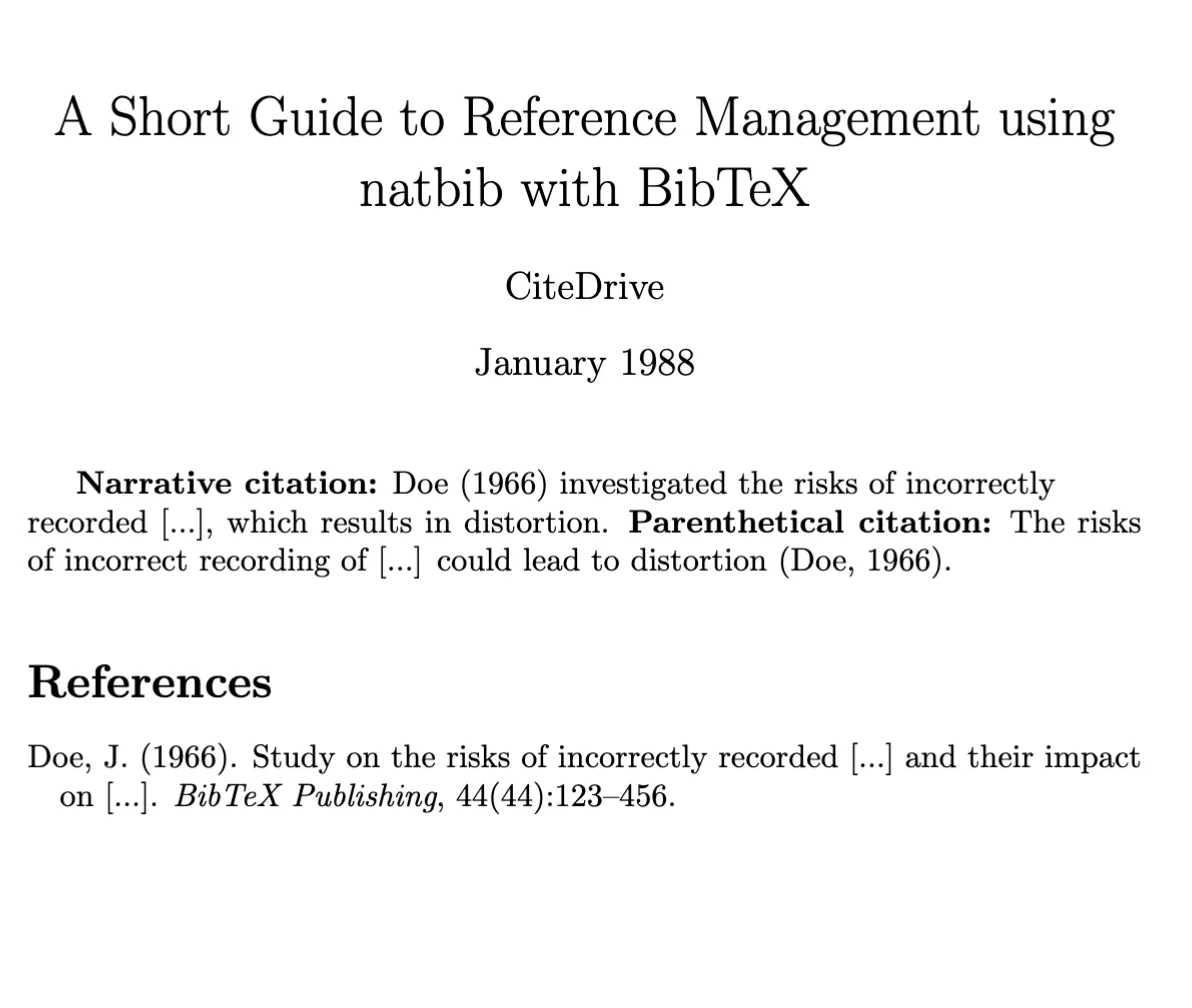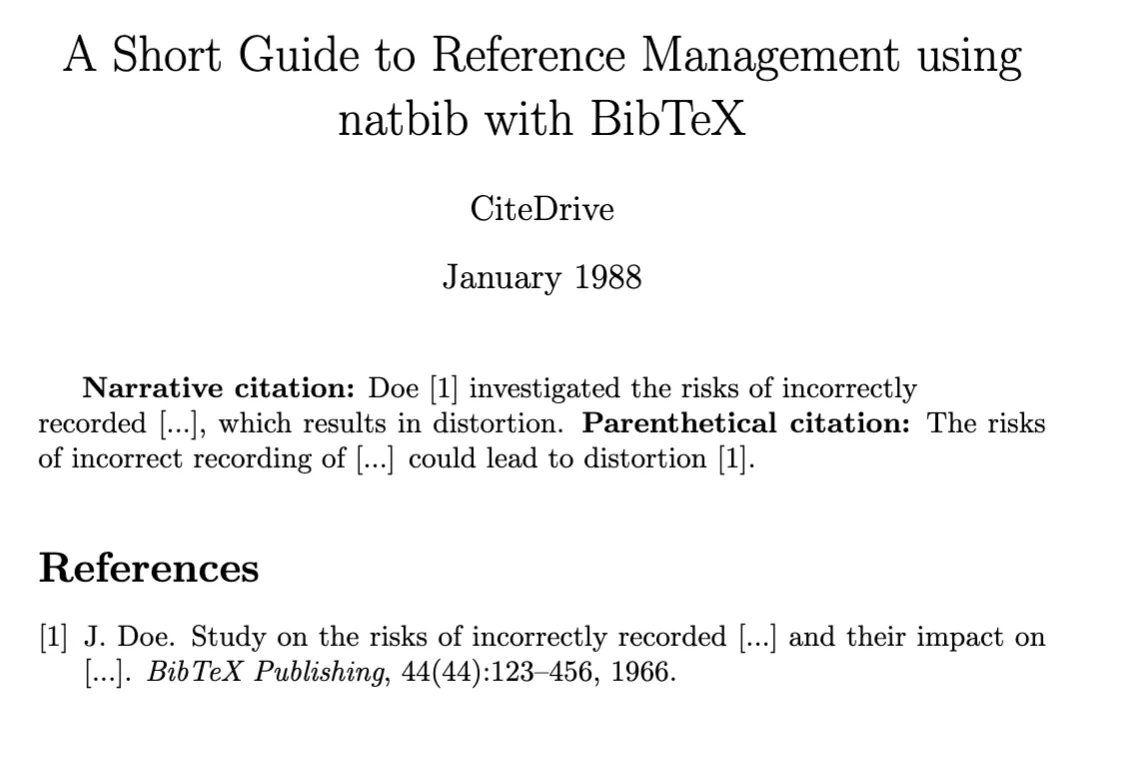
Managing bibliographic references in LaTeX becomes streamlined and efficient with the natbib package. Whether you’re working with the traditional \cite command or diving deep into advanced citation methods, this guide provides foundational insights to get you started.
The natbib package extends the capabilities of the standard \cite command in LaTeX. It particularly shines in in-text citations with various options and customizations, especially for author-year schemes and displaying textual and parenthetical citations when integrated with BibTeX.
Good to know: the package seamlessly works with both author-year and numerical citations and supports the standard bibliography *.bst files.
Let’s delve into the details of how to harness the power of natbib to format and cite your bibliographic sources.
Setting up natbib requires a similar structure to the standard LaTeX setup. Start by loading the library using \usepackage . The library offers several configuration options via \usepackage[options] , discussed in detail below. The primary citation commands in Natbib are \citet for textual/narrative citations and \citep for parenthetical citations.


Output example of reference management using natbib with BibTeX in numeric style
Understanding the range of cite commands provided by natbib allows you to cite sources efficiently. This table breaks down their outputs:
| Command (single citation) | Output (author-year) | Output (Numeric) | Command (Multiple citations) | Output (author-year) | Output (Numeric) |
|---|---|---|---|---|---|
| \citet | Doe (1966) | Doe [1] | \citet | Doe (1966); Smith (2017) | Doe [1], Smith [2] |
| \citet[chap.~4] | Doe (1966, chap. 4) | Doe [1, chap. 4] | \citet[chap.~4] | Doe (1966); Smith (2017, chap. 4) | Doe [1], Smith [2, chap. 4] |
| \citep | (Doe, 1966) | [1] | \citep | (Doe, 1966; Smith, 2017) | [1, 2 |
| \citep[chap.~4] | (Doe, 1966, chap. 4) | [1, chap. 4 | \citep[chap.~4] | (Doe, 1966; Smith, 2017, chap. 4) | 1, 2, chap. 4] |
| \citep[see][] | (see Doe, 1966) | [see 1] | \citep[see][] | (see Doe, 1966; Smith, 2017) | [see 1, 2] |
| \citep[see][chap.~4] | (see Doe, 1966, chap. 4) | [see 1, chap. 4] | \citep[see][chap.~4] | (see Doe, 1966; Smith, 2017, chap. 4) | [see 1, 2, chap. 4] |
| \citet* | Doe (1966) | Doe [1] | \citet* | Doe (1966); Smith (2017) | Doe [1], Smith [2] |
| \citep* | (Doe, 1966) | [1] | \citep* | (Doe, 1966; Smith, 2017) | [1, 2] |
Other natbib commands, such as \citealp and \citealt , offer additional flexibility by suppressing brackets. Discover the entire range of commands in the Reference sheet for natbib usage.
When working with natbib , customizing its behavior can make your workflow smoother. Here’s a breakdown of the options available via \usepackage[options]
| Option | Description |
|---|---|
| round | displays round parentheses |
| square | displays square brackets |
| curly | displays curly braces |
| angle | displays angle braces |
| semicolon | multiple citations are separated by semicolons |
| colon | same as semicolon |
| comma | multiple citations are separated by coma |
| authoryear | display author-year citations |
| numbers | display numerical citations |
| super | displays superscript numbers for numerical citations |
| sort | sorts multiple citations in order of references displayed in bibliography. |
| compress | sorting and multiple numerical citations are compressed where appropriate |
| sort&compress | multiple numerical citations are compressed where appropriate |
| longnamesfirst | the full name of the author appears in the first citation |
| sectionbib | redefines \thebibliography to output \section instead of \chapter |
| nonamebreak | Displays all author names of a citation in one line |
Harnessing natbib with BibTeX simplifies reference management in LaTeX. This guide offered a comprehensive walkthrough from basic setups to intricate citation styles. For more insights into LaTeX and its many functionalities, explore our collection of in-depth guides.